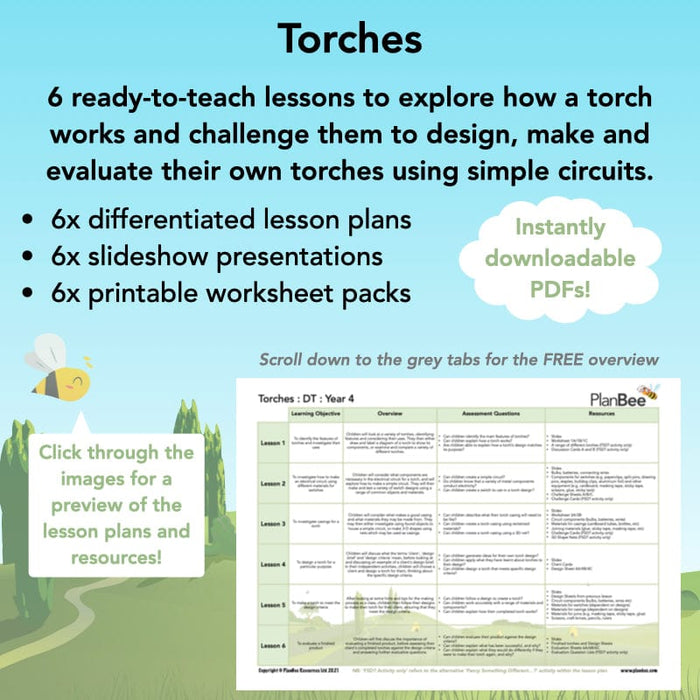
Torches
Unlock huge savings with a PlanBee Subscription
Instant access to our entire library of resources from just £6.49 a month. Find out more

Unlock huge savings with a PlanBee Subscription
Instant access to our entire library of resources from just £6.49 a month. Find out more
Your class will explore different types of torches, the materials they are made out of and their varied uses, as well as investigating how torches work by creating simple circuits. After exploring which types of switches and casings are most effective and why, your class will then have the opportunity to design, make and evaluate their very own torches.
Each of the six lessons within this Torches KS2 scheme includes a detailed plan, a set of informative slides for the teaching input, differentiated activity ideas and printable resources.
This first Torches KS2 lesson introduces children to a variety of different torches and allows them to investigate their materials, uses and components.
Children will look at a variety of torches, identifying features and considering their uses. They then either draw and label a diagram of a torch to show its components, or in groups, examine and compare a variety of different torches.
An easy-to-follow plan, engaging slideshow and differentiated resources are all included in this first Torches KS2 lesson pack.
This practical Making Switches KS2 lesson gives your class the opportunity to consolidate their knowledge of simple circuits and to investigate how to make different switches that would be appropriate for a torch.
Children will first consider what components are necessary in the electrical circuit for a torch, and then will explore how to make a simple circuit. Using their circuit, they will then make and test a variety of switch designs using a range of common objects and materials.
This Making Switches KS2 lesson includes everything you need - a detailed plan, a set of slides for the teaching input and printable resources.
After discussing what properties a torch casing would need, your class will undertake practical activities to help them find out which materials they would use to create the case for a torch.
Children are challenged to either use found objects to house a simple circuit, or create 3-D shapes using nets which may be used as casings.
A lesson plan, slide show, differentiated activity ideas and printable resources are all included in this Torches KS2 DT pack.
In this lesson, your class will have the chance to design their own torches based on a client's specific design criteria.
Children will first discuss what the terms 'client', 'design brief' and 'design criteria' mean, before looking at and discussing an example of a client's design brief. In their independent activities, children will choose a client and design a torch for them.
This How to Design a Torch pack comes with a lesson plan, a set of slides for the teaching input, as well as differentiated, printable resources.
In this Making a Torch KS2 lesson, children will first look at some hints and tips for the making process as a class, before following their designs to make a torch for their client.
An easy-to-follow plan, as well as a set of slides for the teaching input, are included in this Making Torches KS2 pack. (Please note that, due to the practical nature of this lesson, worksheets are not necessary and, therefore – not included. Children may refer to completed worksheets from previous lessons.)
Now that you have a classroom full of working torches, it is time for your class to reflect on the designing and making process and to evaluate their finished product.
Children will first discuss the importance of evaluation, before assessing their client's completed torches against the design criteria and answering further evaluative questions.
In addition to differentiated Evaluation Sheets, a detailed plan and a set of slides for the teaching input are included in this final Torches KS2 DT lesson pack.
Download a free overview to support your teaching of this scheme of work.
Download a free, editable assessment grid to support your teaching of this scheme of work.